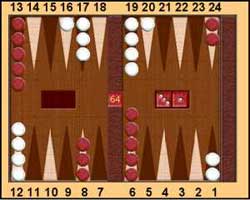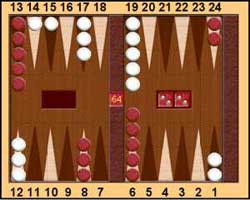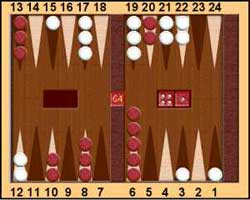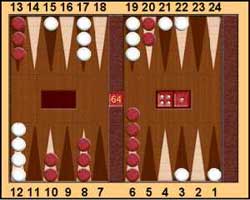
|
Early Game Strategy |

|
A Look at the Golden Point |
| Michael Crane |
|
This article previously appeared on www.msoworld.com December 2000 |
Here, White rolled an opening 4-1 and aggressively played 13/9, 6/5, launching an early attack on your Golden Point. Should you ignore his efforts and make his Golden Point (your 5-point) or hit him? The answer is to hit him. Why? Because if he is allowed to make this point next roll he will have robbed you of the opportunity to hold it and will have made two vital points in his inner board. If this is the case then why not make your own 5-point? Well let's not forget what we are discussing here; whether or not to make the Golden Point, not the 5-point. Given the choice (nearly) always go for the Golden Point before your 5-point. In this position not only will you be frustrating his attempt to make his 5-point but you will be knocking him back a long way in the race — and giving yourself a possible 15 rolls next time to make the point yourself. Holding the Golden Point gives you tremendous opportunities. Men placed on the bar cannot be kept on the bar and can be re-entered safely; and any spare men on here can be used to hit outer board blots without giving up the stonghold. In Magriel's Backgammon, he argues the case for making the Golden Point when you feel that your back men are in danger of being trapped; as in this position:
Here Magriel advocates making the Golden Point as White's earlier play of 3-2, moving 13/10, 13/11, is threatening to make it next roll with any of 15 possible rolls. However, when we look at JellyFish best moves for this position on Level 7 we see that making the Golden Point only comes out 3rd best:
0.125 13/11(2), 6/4(2) This would have us believe that the standard 2-2 move of 24/20(2), 6/4(2) is favourite and when a truncated rollout is done JellyFish still rates the Golden Point move as 3rd, and with an increased margin:
0.141 13/11(2), 6/4(2) So, what is a player to do? The best advice is that, until you have gained more experience in the game, make the Golden Point. Give it top priority when given the choice to make it or to prevent an opponent from making it. Breaking the Golden PointSo, you decide to make it ... when do you decide to leave it? Too many players leave it too soon — often tempted into doing so by a more experienced opponent setting up blots just for that purpose. If you do leave it you have to get something very good in return.Would you leave the Golden Point in this position?
White has played from his mid-point and left you a great shot with any five, so what are you waiting for, hit him! Well if you did hit him you've just made a big mistake. You only hold the 6-point in your inner board and unless he rolls double six he's going to re-enter easily, perhaps with a return shot and that'll leave you on the bar facing three closed points. In fact if he rolls 3-3 you'll have two men on the bar and will be facing four consecutive closed points! The play here is to ignore the blatant attempt to lure you off and to play safely 13/8. So, you didn't hit him then but what about now?
White has played from his mid-point and left you a great shot with any five, so what are you waiting for, hit him! Well if you did hit him you've just made the correct play! This time he has two inner board blots and therefore the risk to you is less. If he does re-enter and hits you onto the bar you're going to have at least one blot to aim at if not two. Leaving the Golden Point is all about risk and gain. Before you do it, ask yourself. "What is the risk to me? What do I gain?" If you think you have more to lose than you have to gain, don't leave it. Remember, whilst you hold this very valuable point you are unlikely to be gammoned; you are covering the outer board; you can take more risks elsewhere on the board because you will always have a safe haven of reentry off the bar; you will make it impossible for your opponent to form a continuous prime; you will make it difficult for your opponent to clear his mid-point should he be ahead in the race. All these benefits from holding just one point — not bad eh? Mind you, these benefits can also count for your opponent if holds his Golden Point. So, in the early stages of the game it is essential you make every effort to make either or both 5-points or to thwart your opponent's attempts to occupy them. No other point on the board is worth more. |

![]()
|
| Other articles on Early-Game Strategy |
|
| Other articles by Michael Crane |
Return to:
Backgammon Galore
 One for Robin
One for Robin


